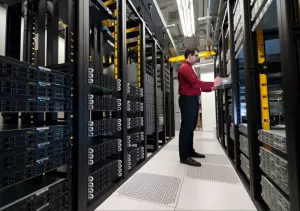As technology keeps on evolving at a rapid pace, call centers in the Philippines commit to system modernization.
Call centers play a crucial role in delivering exceptional customer service and support. However, many call centers in the Philippines still operate with legacy systems. As a result, their ability to keep up with evolving customer expectations is hindered.
Today, we will explore the challenges faced by call centers with legacy systems. Also, we will look into some strategies and best practices for system modernization. After all, through modernization, call centers in the Philippines can unlock new levels of efficiency, scalability, and customer experience.
Legacy Systems Defined
In a call center setting, a legacy system refers to outdated or older technology infrastructure, software, or applications that have been in use for a long time. These systems were typically implemented in the past and may have served the call center’s needs adequately at that time.
However, as customer expectations change, legacy systems may no longer meet the requirements of a modern call center. Hence, the need for legacy system modernization approaches.
Legacy systems in call centers are often characterized by their limitations in terms of functionality, scalability, and integration capabilities. They may rely on older hardware, run on outdated software versions, or use proprietary protocols that are no longer supported.
These systems are typically inflexible, making it challenging to adapt to changing business needs or incorporate new communication technologies.
One common example of legacy systems in call centers is the traditional on-premises PBX (Private Branch Exchange) phone systems. Another one is outdated customer relationship management (CRM) software. Additionally, homegrown or customized applications that lack modern features and integrations are in need of an update.
Challenges with Legacy Systems in Call Centers
Call centers relying on outdated technology face several challenges that can impede their growth. Legacy systems often lack the necessary scalability and flexibility to handle increasing call volumes, resulting in bottlenecks and inefficiencies.
These systems are not designed to support emerging customer service trends such as multichannel communication and automation. Therefore, it’s important for call centers in the Philippines to address these challenges through system modernization.
Let’s consider a scenario where a call center has been using a legacy on-premises PBX phone system for many years. The system was installed when the call center initially started its operations and has been serving its basic needs adequately. However, as the call center grows, the limitations of the legacy system become more apparent.
The call center management recognizes the need to modernize the system to improve efficiency, scalability, and customer experience. They start exploring options for a cloud-based contact center solution that can offer advanced features, seamless integrations, and scalability.
However, they encounter several challenges during the system modernization process:
-
Cost Concerns
The call center management realizes that migrating from a legacy system to a cloud-based solution requires a significant upfront investment.
More specifically, they need to consider the costs of new hardware, software licenses, and implementation services. Unfortunately, the budget constraints of the call center make it challenging to allocate the necessary funds for the modernization project.
-
Disruption to Operations
The call center operates 24/7 to provide uninterrupted customer support. But the system modernization process will require a transition period where the old system needs to be replaced with the new solution.
Understandably, the management is concerned about potential disruptions to ongoing operations during this transition. After all, any downtime or service interruptions could impact customer satisfaction and business reputation.
-
Training and Change Management
The call center has a large team of agents who are accustomed to the features of the legacy system. Therefore, introducing a new system means that agents will need to be trained on the new interface, features, and processes. Because of this, the management anticipates resistance to change. There is also the need for comprehensive training programs to be formulated.
-
Data Migration
The legacy system contains a vast amount of customer data, call logs, and historical records. Migrating this data to the new system accurately and securely poses a significant challenge.
The call center management needs to ensure that all data is transferred to the new system without loss or corruption. More importantly, they need to consider data privacy and compliance regulations during the migration process.
-
Integration with Existing Systems
The call center relies on various applications and software systems, including CRM, ticketing, and workforce management tools. Integrating the new cloud-based contact center solution with these existing systems is crucial for seamless operations and efficient workflows.
However, the legacy systems may have limited integration capabilities. This will then make it challenging to achieve the desired level of connectivity and automation.
Benefits of Modernizing Legacy Systems
Modernizing legacy systems brings a couple of benefits for call centers in the Philippines:
-
Enhanced Operational Efficiency
Through modern technologies and infrastructure, call centers can significantly enhance their operational efficiency. This includes streamlining workflows, automating repetitive tasks, and optimizing resource allocation. As a result, call centers can handle higher call volumes, reduce wait times, and improve overall customer satisfaction.
-
Better Customer Experience
Moreover, system modernization enables call centers to provide an enhanced customer experience. With the help of new communication channels and technologies, call centers can offer a seamless and personalized experience to customers.
This includes implementing multichannel communication platforms that allow customers to interact through their preferred channels. Additionally, automation and AI technologies can help call centers deliver faster and more accurate responses.
Replacing Legacy Systems?
The benefits of replacing legacy systems should also be considered by Philippine call centers. These benefits also include an enhanced customer experience and improved efficiency through various facets like data analysis, better integration capabilities, and enabling remote work.
Additionally, better security features are usually promoted by more modern call center systems, aiding in regulatory compliance and future-proofing plans.
The Philippines: A Hub for Call Centers
The Philippines has emerged as a prominent hub for call centers, known for its large pool of English-proficient workforce.
But besides that, the country is also known for its geographical location and cultural affinity to Western countries. As a result, the Philippines has attracted numerous multinational companies seeking cost-effective and high-quality customer service solutions.
However, to maintain its position as a preferred destination for call center operations, the Philippines must adapt to trends in legacy system modernization. To do this, call centers in the country must ensure that they have the necessary infrastructure and technology in place.
Modernization Strategies for Call Centers in the Philippines
Call centers in the Philippines can adopt various legacy system modernization approaches tailored to their unique needs and challenges. The first step is to conduct a thorough assessment of the existing systems. This serves as the foundation for developing a modernization roadmap.
-
Cloud-Based Solutions
One key strategy is to leverage cloud-based solutions. Cloud technology offers scalability, flexibility, and cost-efficiency, allowing call centers to adapt to changing business demands. Through cloud migration, call centers can reduce hardware and maintenance costs while gaining access to advanced features and capabilities.
-
AI and Automation
Automation and AI technologies are also instrumental in system modernization. In fact, Robotic Process Automation (RPA) can automate repetitive and manual tasks. This frees up agents’ time to focus on complex customer inquiries.
AI-powered chatbots and virtual assistants, meanwhile, can handle routine queries, provide instant responses, and even perform transactions. These technologies enhance efficiency, reduce response times, and elevate the overall customer experience.
-
Multichannel Communication Integration
Integration with multichannel communication platforms is another crucial aspect of modernization. Call centers need to meet customers on their preferred channels, whether it’s voice, email, chat, or social media. A multichannel approach ensures a consistent customer experience across all touchpoints, improving satisfaction and loyalty.
Best Practices for Successful Modernization
Successful legacy system modernization approaches need to be holistic. Here are some best practices to achieve this success:
-
Collaboration between IT and Stakeholders
Collaboration between IT teams and call center stakeholders is essential to align technology initiatives with business objectives. In working together, they identify the most appropriate solutions, address implementation challenges, and ensure smooth integration with existing processes.
-
Gradual Adoption
In addition, a phased approach to implementation is recommended. This allows for gradual adoption of modern technologies and minimizing disruption to ongoing operations. Plus, it enables improvements and allows the call center to learn from early successes and challenges.
-
Training and Upskilling
Investing in training and upskilling employees is crucial for a successful system modernization. Employees need to be equipped with the necessary skills to leverage new technologies effectively. Training programs can help them understand the benefits of modernization, adapt to new tools and systems, and deliver exceptional service.
-
Continuous Monitoring and Evaluation
Finally, continuous monitoring and evaluation of modernized systems are vital to identify areas for further improvement and optimization. Call centers should first examine key performance indicators such as response times, customer satisfaction ratings, and operational efficiency. Through such metrics, call centers can refine their processes and enhance their performance.
Why Outsourcing to a Modernized Call Center in the Philippines Makes Sense
Outsourcing to a call center in the Philippines that enjoys modernization benefits offers numerous advantages for businesses looking to improve their operations and customer service. Let’s take a look at how outsourcing to a modernized call center in the Philippines can help businesses improve:
-
Cost Savings
Outsourcing to the Philippines can significantly reduce operational costs for businesses. The labor costs in the Philippines are generally lower compared to Western countries. This allows businesses to access a skilled workforce at a more affordable rate.
Moreover, outsourcing eliminates the need for businesses to invest in expensive infrastructure, technology, and recruitment processes. The cost savings achieved through outsourcing can be redirected towards core business activities, innovation, or expansion.
-
Access to Skilled Workforce
The Philippines is renowned for its pool of highly skilled and English-proficient professionals. Therefore, outsourcing to a modernized call center in the Philippines provides businesses with access to trained agents who possess excellent communication skills.
These agents undergo rigorous training programs so that they can handle customer inquiries effectively and provide top-notch service. With the expertise and language proficiency of Filipino agents, businesses can enhance their customer interactions and build stronger customer relationships.
-
24/7 Availability
Modernized call centers in the Philippines operate round-the-clock, offering 24/7 availability for businesses and their customers. This means that businesses can provide customer support and handle inquiries regardless of their own time zone. An enhanced availability means customers receive timely assistance and support, leading to increased customer satisfaction and loyalty.
-
Multilingual Support
The Philippines is known for its linguistic capabilities, with agents proficient in various languages beyond English. This multilingual support is advantageous for businesses with diverse customer bases or those targeting specific language markets.
Outsourcing to a modernized call center in the Philippines allows businesses to cater to customers in their preferred language. Because of this, the overall customer experience is improved.
-
Scalability
Call centers in the Philippines offer scalability, allowing businesses to adjust their support capacity based on demand fluctuations.
Whether it’s seasonal spikes or unexpected growth, outsourcing provides the flexibility to quickly adjust the number of agents to match customer needs. This scalability ensures that businesses can maintain high service levels during peak periods and optimize cost-efficiency during slower periods.
-
Advanced Technology Infrastructure
Modernized call centers in the Philippines boast state-of-the-art technology infrastructure. This includes advanced telephony systems, cloud-based solutions, data analytics tools, and CRM integration.
These technologies enable seamless customer interactions, efficient call routing, real-time reporting, and access to customer data for personalized service. Through outsourcing, businesses can leverage these cutting-edge technologies without the need for substantial investments in their own infrastructure.
-
Focus on Core Competencies
Outsourcing customer support to a call center in the Philippines allows businesses to focus on their core competencies.
More specifically, modernized call centers empower businesses to allocate more resources to product development, marketing, and other critical areas. This improved focus on core competencies can lead to increased competitiveness and overall business growth.
Summary
For call centers in the Philippines, modernizing legacy systems is no longer an option but a necessity. Through modern technologies, infrastructure, and best practices, call centers can overcome the challenges posed by legacy systems.
System modernization brings numerous benefits, including increased operational efficiency, improved customer experience, scalability, and integration with emerging trends. The Philippines, with its thriving call center industry, can position itself as a leader in providing cutting-edge customer service solutions.
Open Access BPO is an industry-leading call center whose Philippine branch is among the best in the country. Our specialty in multilingual and multichannel customer support, as well as our back office solutions, is supported by the updated and certified technologies that we use.
What’s more is we operate under the best data security practices to ensure a high level of trust from our clients and their customers.
Visit Open Access BPO’s website to learn more about our solutions.
Call centers in the Philippines have been making their rounds in tech talks and outsourcing forums lately as investors ask more and more about the technological readiness of the outsourcing companies they entrust their business processes to.
It’s only natural for clients to know if their money is being put into good use and if their critical data is being protected. This puts more pressure on outsourcing firms to keep up with technological advancements and meet customer needs that are changing in sync with technology. And a crucial step towards that is modernizing legacy applications.
However, integrating older software with new systems and current customer demands will only be successful if the contact center understands the benefit of revamping its system and uses a wise combination of new programs to add and old applications to retain.
Advantages of modernizing call center systems
According to Jeffrey Bolden, Managing Partner at IT service firm Blue Lotus, contact centers could have these four benefits by having modern systems: analytics, call flow tracking, universal communications, and customer relationship management. Gaining these, call centers in the Philippines could answer questions faster through a centralized caller database and gauge metrics such as hold time length and call routing destinations.
Modern contact center tools
Businesses swear that adding the following tools to their existing call center system can significantly enhance employee performance and customer engagement:
-
Instant messaging
Blue Lotus and dental solutions company DenMat claimed that positioning live chat alongside their voice-based services not only gave customers quicker answers but also allowed employees to consult experts in real-time. This removed frustration from outdated systems and eventually cut their 23% attrition rate to 7%.
-
Cloud storage
DenMat unified the database for its three contact center units to give all agents access to the customers’ full profile and business history with the company, thus eliminating callbacks and multiple call transfers.
-
Call tracker
Aside from feedback collection benefits, call tracking lets agents follow calls they forwarded to be sure that the caller received a resolution from the agent who took the transferred call. Relationship aid company Pure Romance attested to the benefit of call tracking, saying that it allowed them to proactively fix product issues and reward top sellers and top clients.
Hybrid system
Although modernizing legacy systems is a must for call centers in the Philippines, it is advisable to keep the ratio at 20:80 instead of dividing the overall system into equal halves of modern and legacy applications.
Blue Lotus’s Bolden suggested retaining 20% of the old system while replacing the 80% with new tools, or vice versa, depending on the company’s needs. Businesses that rely much on web capacity should have systems that are brand new or at least relatively up-to-date, while those that are after the modernization of smaller work aspects should keep much of their legacy tools.
A legacy-dominated system is ideal from a budgetary standpoint, especially if the whole workforce needs to be trained for the tech improvements.
To fortify their dominance in the Asian outsourcing field, Philippine call centers must indeed keep up with the technological evolutions, but they would only be successful in doing so if they understand the benefits of modernization and balance the changes they would apply.
Open Access BPO uses the best technologies and the most reliable communication channels to ensure unhampered call center operations.



